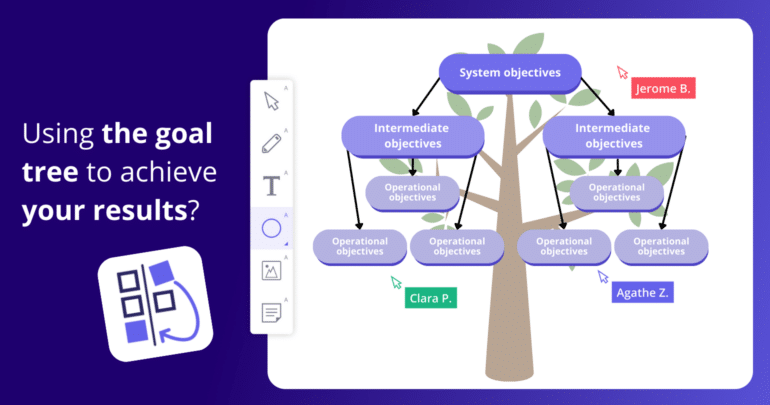Welcome to the world of strategic planning and effective goal management! In this article, we will explore a powerful and valuable tool, often referred to as a “means-ends tree” or “tree analysis”: the goal tree. This is an essential instrument that will help you provide a clear and organized structure to complex objectives by breaking them down into sub-goals or specific actions.
How does it work?
At the top of the tree is the main objective. It is followed by intermediate objectives, each of which contributes significantly to the achievement of the overall objective. Thus, when you visualize the goal tree, you get a graphical representation of the hierarchical relationships between different levels of objectives, while clearly identifying the contribution of each intermediate objective to the accomplishment of the final goal.
The goal tree is particularly used at the beginning of a project as it provides a structured approach to define and prioritize qualitative and quantitative objectives. By integrating this method at the outset of the planning process, the project’s chances of success are significantly increased, and you can achieve your outcomes more easily!
The goal tree to achieve your results:
Defining objectives for the realization of your projects is crucial; however, these objectives must be clear in order to attain them. By having a hierarchy of objectives and clarifying them, you provide a clear direction to all members of the organization, allowing them to set their own goals and align their individual and collective efforts toward achieving these objectives.
Beekast offers a range of activities and features that enable you to use the goal tree to achieve your results:
- Icebreaker ESVP: We always recommend starting a discussion with an “icebreaker” activity. This not only helps to relax the atmosphere but also ensures that all participants feel engaged in the process.
To create a goal tree truly effectively, there’s nothing like kicking off with the ESVP (Explorer, Shopper, Vacationer, Prisoner) icebreaker! This approach allows you to quickly assess the motivation of your participants.
For instance, if one of your team members identifies as a “Prisoner,” it may indicate that they are not fully committed to the project, potentially hindering idea sharing and potentially negatively impacting the results of your goal tree.
The solution? Initiate an open discussion to explore their concerns and collectively find ways to encourage the adoption of other behaviors, such as exploration, sharing, and appreciation. You will then witness a significant improvement in team collaboration and more relevant outcomes.
- The “Prioritization Activity”: Once you’ve collected all the ideas from your team, it’s time to determine where to start!
The prioritization activity provides you with a concrete way to decide which objectives deserve immediate attention and where your team members should focus their efforts. They simply assign a certain number of points to different proposals based on their importance. This will then allow you to clearly identify priorities.
Through this approach, your team members will first focus on the most crucial and impactful actions. They will initially target operational objectives, gradually progressing towards intermediate goals, all with the ultimate aim of achieving the main system objective. You will thus witness a more focused and effective workflow emerging within your team.
- The “Canvas Activity”: Ready to create your goal tree? Get ready because this step will allow you to bring your ideas to life visually and impactfully! Visuals play a crucial role in understanding and communicating objectives, and this is where this activity truly shines.
With our Canvas activity, you will have access to a collaborative whiteboard that enables you to create your goal tree freely and flexibly. It’s an ideal tool for sketching and defining the main objectives while breaking them down into intermediate goals.
- “Actions and Decisions” Feature: This feature is a valuable asset in pursuing the goals of a project as it simplifies the management of tasks to be undertaken while encouraging informed decision-making.
Once you have carefully planned the actions, it’s time to assign them to your team members. They will receive deadline reminder emails, which will help them keep their follow-up up to date before the next meeting, ensuring that the project progresses smoothly and that tasks are completed on time!
In summary, the goal tree stands as an invaluable strategic tool for defining and tracking objectives, whether they are professional or personal. It proves essential in the planning, management, and achievement of these goals.
With this tool, you can also establish a clear hierarchy among your objectives by ranking them based on their importance and priority. This approach greatly simplifies decision-making and the efficient allocation of available resources. This is how, with Beekast, you can easily define your objectives and track their progress by your team members, thereby promoting the advancement and success of your professional or personal initiatives.

